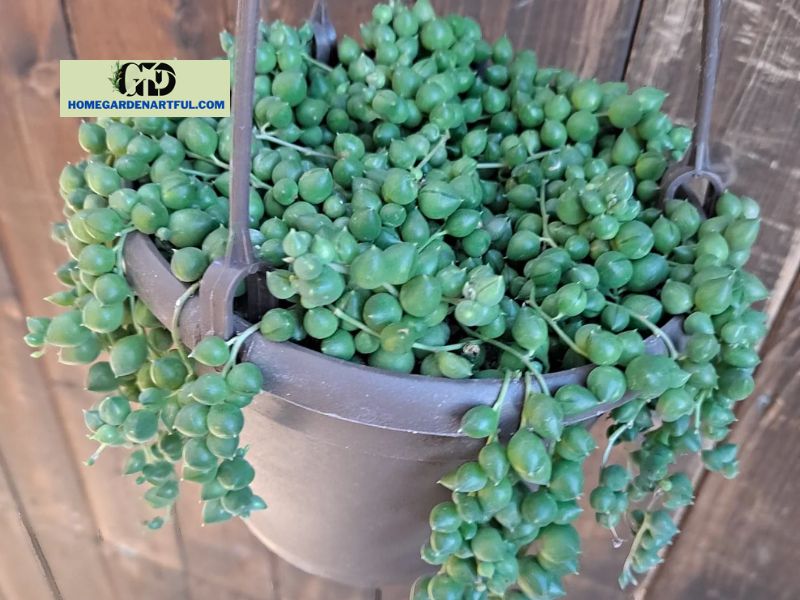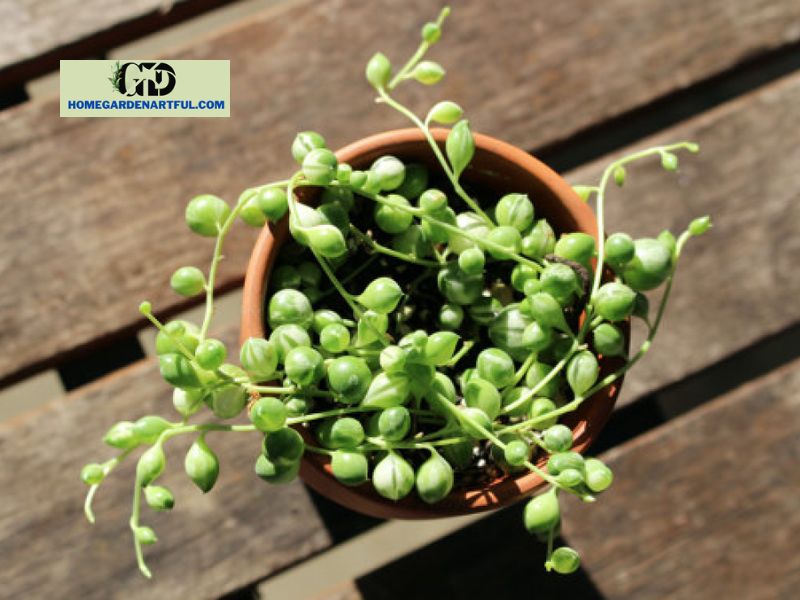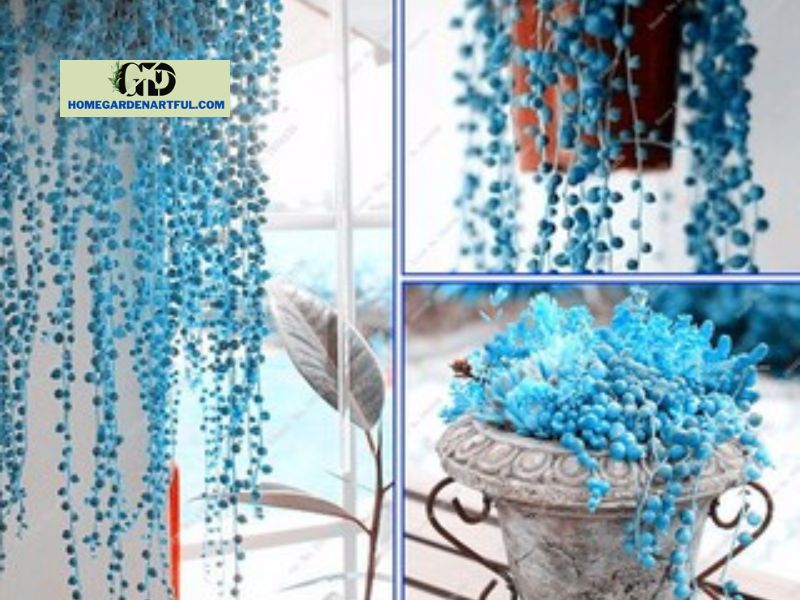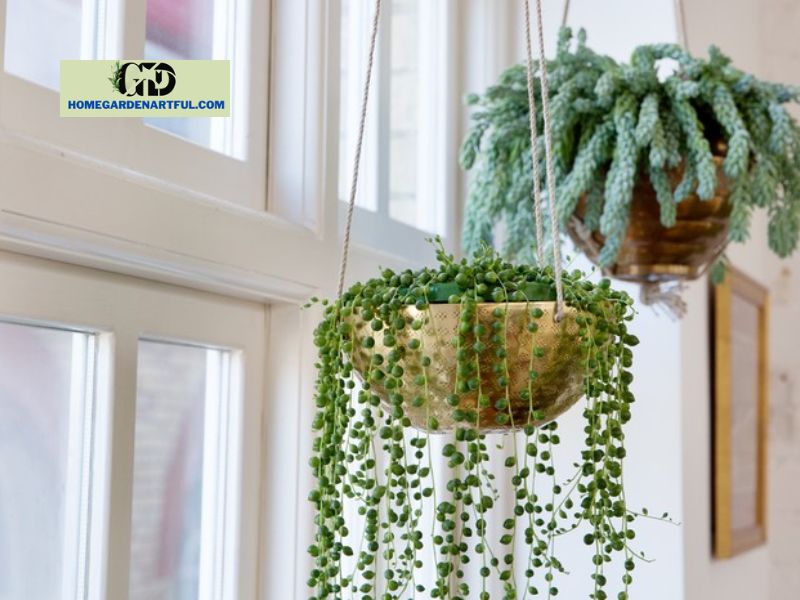Is Blue String Of Pearls Plant real? The string of pearls is a peculiar plant from South Africa with spherical leaves. In the wild, scientists identified it as Senecio rowleyanus, a succulent in the genus Curio.
The plant grows from a shaky network of surface roots. Before the plant contacts the soil and establishes another root network, the trailing stems can grow up to 3 feet long. Since the plant prefers not to be in direct sunlight, it thrives among other plants or, on occasion, among rocks.
Gardeners love to plant string of pearls in a bowl or other container when growing them at home. The succulent will trail over the side, resembling a string of pearls.
This plant is normally light green in color. A darker stripe runs down one side to aid with photosynthesis. White stripes can be found on some other types. Of course, the question today is whether or not there are blue string of pearl plants. Let homegardenartful.com investigate.
Is Blue String Of Pearls Plant real?

No.
There are no blue string of pearl plants, despite the lovely photo you’re looking at. To say the least, it’s a letdown. However, it is also an educational opportunity to learn about seed fraud.
Unfortunately, there are internet vendors who deceive. They’ll manipulate plant images like a string of pearls. Pictures with brilliant colors and lovely vegetation will entice a shopper. However, if anything appears to be too good to be true, it most likely is.
In fact, if your pearl string suddenly acquires a blackish or purplish-blue tint, it could indicate that something is amiss with your plant. It could be caused by overwatering, underwatering, or another disease, and you should look into it.
Protect Yourself
Prevent yourself from being disappointed. There are several approaches to making seed purchases. If you follow our advice, you will not be duped. Agricultural fraud is a genuine and serious issue.
Recognized Distributors
Instead of buying seeds from an unknown Amazon seller, you could be better off placing your money in the hands of reputable independent plant sites. It can be simple to make a purchase through a large box website, but frauds are widespread.
Unusual Costs
Is that offer too good to be true? It most likely is. Take a few moments to compare comparable products on different websites. If the price is too low, walk away.
Exceptional Varieties
Several additional hoaxes, like the blue string of pearls, are not real. Purple watermelon and green sunflowers may appear exotic, but they are not real.
Blue isn’t the only color plant scammers try to counterfeit in the case of the string of pearls. There are photographs of a string of pearl plants in yellow, purple, red, and pink. Unfortunately, they aren’t real.
Care for String of Pearls

Light
String of Pearls plants should be planted indoors or outdoors in a location that receives at least 6 to 8 hours of bright, indirect sunshine every day. However, to grow this plant outside, you must choose a somewhat shaded location.
If kept indoors, put your String of Pearls near an east-facing window where it will receive ample of bright natural light. Planting it near a South or West-facing window would also suffice, as long as you keep the plant 5 to 10 inches away from the window, particularly if you live in a hot, desert-like environment, to avoid sunburn. Think about moving them to a brighter place or closer to the window during the darker, cooler months to ensure they get enough light per day.
If your home does not have enough light for your String of Pearls, consider placing them 6 – 12 inches under a fluorescent light source for roughly 12- 16 hours every day.
Watering
String of Pearls are quite sensitive to overwatering, so ensure you just give them what they need. Once every 2 weeks is the recommended amount. To avoid overwatering your plant, check to see if the soil is half an inch (1.2cm) dry before watering again. Reduce watering to once a month throughout the winter.
A string of pearls is commonly cultivated indoors, however, this does not exclude it from being an excellent outdoor plant. For outdoor String of Pearls, you can alter the number of times you water the plant according to how hot the area is, or you can let the rain do the job for you.
Temperature
String of Pearls succulents should be kept at an average indoor temperature of 70° – 80° F. Keep the plant cool during the winter, around 55° – 60°F. Keep them away from drafts, air conditioners, and open windows, as cold air can cause the leaves to drop. Because a string of pearls is not frost-resistant, they must be relocated indoors throughout the winter.
Humidity

String of Pearls does not need much humidity to thrive. In reality, because the plant is native to dry places, dry air would not hurt it. Furthermore, it can be enjoyed in practically any regular household humidity setting.
Soil and pot
Pearls Plants, especially succulents, require well-draining soil to thrive. As a result, selecting a well-drained pot is the very first step in making your spring of hearts happy. Because of their excellent drainage, terracotta and unglazed ceramic pots are the 2 most common options.
Conclusion
As much as we wish it were true, a blue thread of pearls does not exist. The real thing, on the other hand, is a vibrant green. It may appear as green and white due to striping along the leaves, but you will not discover blue.


